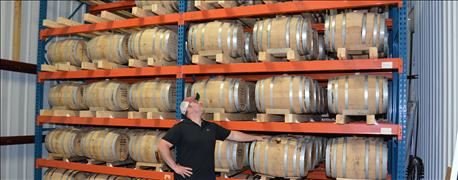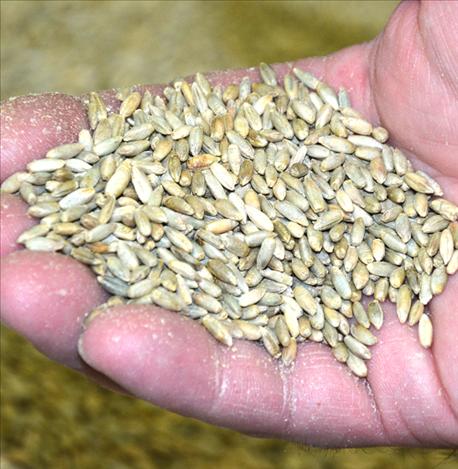
Michael Swanson and Cheri Reese know what happens to the rye and corn they raise on Michael’s fourth-generation farm.
Those crops don’t travel far. From the field, they head for the on-farm distillery to be milled, mashed, fermented, distilled and bottled into the couple’s small-batch, craft-distilled whiskeys, gins, rum and vodka. Far North Spirits is the name of their value-added business, located near Hallock.

AGING THE PRODUCT: Michael Swanson stands in the aging room at Far North Spirits. He buys white oak barrels in 3-, 15- and 30-gallon sizes from three Minnesota coopers.
After working on a small business plan for an assignment in a master’s in business degree program, Swanson and his wife, Reese, made the decision to leave their metro corporate jobs and relocate to the farm. Their goal is to make Minnesota a leader in rye grain production and to produce world-class rye whiskey using non-GMO grains.
Swanson and his dad, Charlie, farm 800 acres, with 300 of those acres in rotation in the rye and corn needed for the distillery. Prior to that, the farm produced wheat, barley, soybeans, canola and sugarbeets — most of which are still grown.
“We hadn’t grown rye or corn on this farm until we decided to build the distillery,” Swanson says. He did some research and decided to raise a Canadian rye, AC Hazlet.
“I selected that for its winter-hardiness and resistance to lodging,” he says. The variety can grow up to 50 inches tall.
Before pouring concrete for the distillery, which from the outside looks like your average machinery shed, he planted his first rye field in fall 2012 and his first 10 acres of corn the following spring, prior to beginning construction.

HARDY RYE: AC Hazlet is the winter rye planted in fields in the fall at the Swanson family farm.
Swanson and Reese built their distillery for expansion. The front of the structure houses a small, comfortable tasting room that opens into the distillery and a 60-by-105-foot distribution floor. On the back side of that is another 20-foot aging room. Two copper stills ��— a small 50-gallon and a larger 500-gallon — are the distilling room’s centerpieces. The smaller still is dedicated to gin, and the larger one to whiskey and rum.
“This is a big distillery by craft standards,” Swanson adds.
The distilling loop
As he led a brief distillery tour, Swanson described the process, which moves product through one big loop. Grain is ground up and cooked, so it releases the starch and prepares it for fermentation. The porridge is cooled down so yeast can be added. From here, the mixture is transferred to fermenting tanks, which Swanson calls “very old-school.”

SMALL-BATCH OFFERINGS: These are four rye spirits offered by Far North (from left). Ålander is spiced rum made from domestically sourced demerara and turbinado sugar and whole spices; Roknar Minnesota Rye is 80% rye, 10% corn and 10% malt barley; Solveig gin, Far North’s first release, contains eight botanicals and has herbal and light floral notes; and Gustaf, named after Swanson’s great grandfather, is a “navy-strength” gin with 11 botanicals, including Meyer lemon, grains of paradise, fennel, coriander and meadowsweet portioned into the blend.
“They are open-top, and craft distillers use them,” he says. This allows for distillers to focus on specific flavors. Fermentation takes three to four days. Then the mixture is transferred to a copper still. To make whiskey, the mix goes through two passes. The first pass boils off everything, and the second pass, called the "spirit run," separates components into three parts that go into different tanks.
To give the spirits distinctive tastes and aromas, Swanson uses a variety of botanicals in the distilling process. For example, grapefruit peel, thyme, coriander, lavender and juniper give their gin, Solveig, a floral nose. It is not like traditional gins that have a pine-needle smell. All botanicals are distilled separately, either boiled directly in the still's pot or vapor-infused in its gin basket.

UP THERE: Far North Spirits, the northernmost distillery in the contiguous United States, is built on Michael Swanson’s family farm, where his Swedish great grandparents Gustaf and Anna Christine Swanson homesteaded near Hallock a century ago.
Whiskey is aged in white oak barrels from one to 4.5 years, Swanson says. He also plans to market a nine-year whiskey. All bottling is done by hand.
MN Cup finalist
Far North enjoyed some big buzz over the summer. The company was one of the three finalists in the food/ag/beverage division of the MN Cup, the nation’s largest entrepreneurial competition. The cup is funded by corporations and educational institutions across the state and managed by the University of Minnesota's Carlson School of Management. This year, the competition drew 1,500 entrants in eight categories.
“We wished we would’ve brought home the $30,000 prize, but we were really happy to have been in the top three,” Reese says.
For more information about the distillery and its products, visit farnorthspirits.com.
Far North to host first Whiskey Fest
Far North Spirits is hosting an all-day Whiskey Fest featuring two new rye whiskeys: Roknar Maryland-Style Rye Whiskey and Roknar 100% Rye Whiskey.
The event will be held from noon to 6 p.m. Nov. 12 at its craft distillery, 2045 220th Ave., Hallock.
Roknar Maryland-Style Rye has a slightly sweeter mash bill — 65% rye, 25% heirloom corn, 10% malt barley — than its predecessor, Roknar Minnesota Rye.
Activities include a cocktail class, cooking demos, a tour of the field-to-glass operation, and samples of wild game prepared on an outdoor fire pit.
“Whether you’re a die-hard whiskey enthusiast or just looking to learn more about the world’s most popular spirit and raise your cocktail game, you’ll enjoy tasting and touring the whiskey-centric world of a truly authentic field-to-glass craft distillery,” says co-owner Cheri Reese.
Tickets are $40 all-inclusive, or $10 for designated drivers. They go on sale Oct. 7 via eventbrite.com or by calling 612-720-3738.
Rye can be cover crop, spirit in Minnesota
Eighty percent or more of winter cereal rye planted in Minnesota is known as "common" or "variety not stated," says Mac Ehrhardt, owner and manager of Albert Lea Seed House, the largest supplier of rye seed in the state. Farmers plant it as a cover crop that is terminated in the spring with tillage or a herbicide when they plant corn or soybeans.
Popular varieties that Ehrhardt sees in fields include:
• Brasetto, a new hybrid winter rye developed by KWS, a German seed-grain developer.
“It is extremely high-yielding, shorter and very good-standing,” Ehrhardt says. “It can be intensively managed, much like winter wheat. It will probably be planted by farmers with an established market with distillers or millers.”
The seed is much more expensive than common rye, he adds. Also, because it is a hybrid, you cannot save seed and replant it out of your bin.
• Aroostook, an old variety that has recently become popular in roller-crimper weed-control systems, is mostly organic.
“ND Dylan is a new variety released by North Dakota that is very high-yielding, and will probably primarily be used by farmers growing rye for grain for milling or distilling,” he says.
Older varieties include Hazlet, which has plump seeds and is used by farmers growing rye for grain for milling or distilling; and Spooner, Wheeler and Rhymin.
Adds Ehrhardt: “If you are going to save your own rye seed to plant out of the bin, make sure it is dry. Winter rye can lose its germination easily.”
About the Author(s)
You May Also Like






